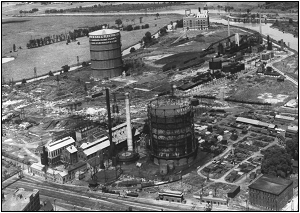 Old Manufactured Gas Plant site in New York. Old Manufactured Gas Plant site in New York.

Light microscopy images of representative organic particle types in a MGP site sediment. PAHs were found largely associated with coal tar pitch.
|
PAH PARTITIONING AND ORGANIC MATTER CHARACTERIZATION IN MANUFACTURED GAS PLANT SITE SEDIMENTS
Investigator: Upal Ghosh
Duration: January 2003 - December 2004.
Funding agencies: Gas Technology Institute and Northeast Gas Association
Background. US EPA’s Risk Assessment Guidance for Superfund calls for the determination of site-specific characteristics that may influence fate and transport of contaminants. The partitioning of PAHs between soil and water is typically determined using standard empirical correlations between sorbate octanol-water partition coefficient (Kow) and sorbent organic carbon normalized partition coefficient (Koc). Such empirical correlations are based on PAH partitioning to natural organic matter present in soils/sediments, and do not account for strong binding with carbonaceous matter like coal, coke, or lampblack that may exist in industrial sites. Our earlier work has shown that it is important to understand the nature of contaminant association with sorbents because hydrophobic organic contaminants such as PAHs may bind very strongly to certain organic carbon types found in soils and sediments impacted by industrial processes.
Research Objectives. This research provides fundamental understanding
of particle-scale binding and assessment of site-specific partition
coefficients for PAHs in sediments from several sites impacted by
Manufactured Gas Plant
(MGP) operations. The sites range from freshwater in the upper reaches
of the Hudson River to the estuarine region downstream. Equilibrium
partitioning measurements for PAHs are hindered by strong partitioning
of the higher
molecular weight compounds to colloidal particulates that are difficult
to separate from the aqueous phase. Two recently developed methods
are being used to measure equilibrium aqueous concentrations of PAHs:
an air-bridge method to keep colloids out of the water phase, and
an alum-flocculation method to precipitate colloidal particles from
the aqueous phase.
A major
objective of this research is to explain scientifically differences
between measured and estimated partition coefficients for PAHs.
This explanation
is aided by density separation of particulate organic matter in
sediments, particle-scale PAH measurements, and petrographic characterizations
to
identify the nature of the organic matter responsible for PAH binding.
In our recent work we have demonstrated that PAHs sorbed on carbonaceous
particles such as soot, coal, coke, and charcoal are strongly bound
and less available than PAHs sorbed on natural organic matter.
Thus,
identification of the geochemical nature of the soil carbon, specifically
the presence
of coal, coke, lampblack, and pitch helps explain differences in
site-specific
values of PAH partitioning from what would have been estimated
using standard empirical correlations. Improved understanding of the nature
of the sorption
process will improve site-specific risk assessment of the impacted
sites. |